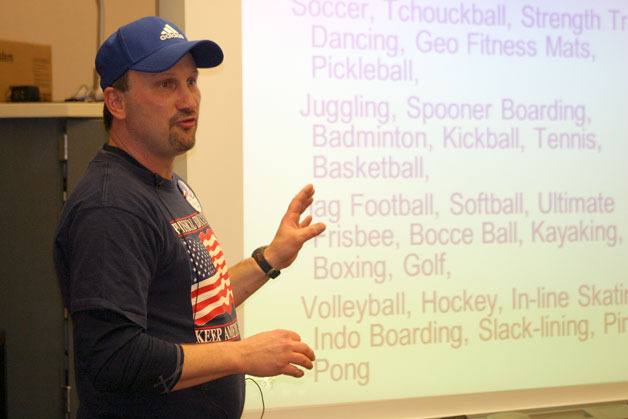LANGLEY — There’s an award-winning teacher on South Whidbey. And he wants to make sure the South Whidbey School District doesn’t cut his chosen programs.
Erik Jokinen, the recent recipient of the Northwest Education Service District physical education teacher of the year award, told the South Whidbey School Board why physical education matters at a recent meeting. In the face of impending budget cuts, likely to hit staff and programs or courses, Jokinen was passionate enough about keeping kids fit to argue for healthy fitness funding next year.
“We have an opportunity to highlight and be proud of this program,” said Jokinen, who teaches at Langley Middle School. “There is no reason an individual in the South Whidbey School District cannot be healthy.”
While the former Washington PE Teacher of the Year’s presentation struck a chord with some parents and educators in the audience at the school board meeting, it struck the board at a time of choices. The South Whidbey School District is projected to enroll about 70 fewer students next school year, which equates to about $500,000 of lost revenue.
District Superintendent Jo Moccia spent her first six months on the job assembling a list of courses and programs the school district offers, then hosted several meetings to hear what the community wants from its schools. The final meeting in the school district’s “Community Conversations” is planned for April 18, at which point Moccia said she’ll relay the information back to the community and have an idea how South Whidbey schools will move forward.
“It’s tough to get everything we want,” said Board Chairman Steve Scoles. “How can we do this and still have the academic component?”
One of Jokinen’s worries was that physical education may lose its mandated status. He had heard some criticism about the amount of time students spend in physical education, rather than art, band, science, math, history or English, and defended his discipline’s importance.
“I don’t want to pit discipline against discipline. PE’s not art, it’s not shop,” Jokinen said. “If we are moving PE to an elective status, then what we’re saying is, ‘If you try PE and you like it, maybe you should stick with it.’”
“I want it to be an essential value.”
A previous critique of the time spent in physical education at Langley Middle School was that it far surpassed the state required minimum of 150 minutes per week. Time in a physical education and health course was reduced to 100 minutes recently, too.
“That doesn’t mean we have to hit the minimum,” Jokinen said.
Given the nature of students’ personal time spent eating junk food and sitting in front of screens (television, computer, phone) Jokinen stressed the need to keep kids active. During his 20-minute presentation, he cited Center for Disease Control and Prevention statistics about obesity in the United States.
“It’s pretty alarming how our diet and sedentary lifestyle have led us down this road,” Jokinen said. “We’re not immune to this.”
As a way to combat potential health problems and incorporate students, Jokinen has championed introducing students to inclusive, lifetime sports and activities. Jokinen and other teachers in the South Whidbey School District have written for and won grants to purchase equipment the district couldn’t afford like roller skates, boxing gloves and balance boards.
“I’d much rather have a kid skating in their driveway than doing this,” Jokinen said as he motioned holding a video game controller.
“These are things kids can get on their own, can do on their own.”
Like other school subjects, physical education has been required to do more with less. No longer just games of basketball or dodgeball, physical education includes health and diet, divided into three quarters of physical education and one quarter of health instruction. At Langley Middle School, Jokinen said the physical education-to-health ratio per week landed at three days of physical education and two days of health one quarter, then switches.
“Show me a teacher who’s going to complete that in a quarter, or a semester or even a year,” Jokinen said.
He added: “There is no other time, and I truly believe this, that we should not be talking about cuts to our PE.”



